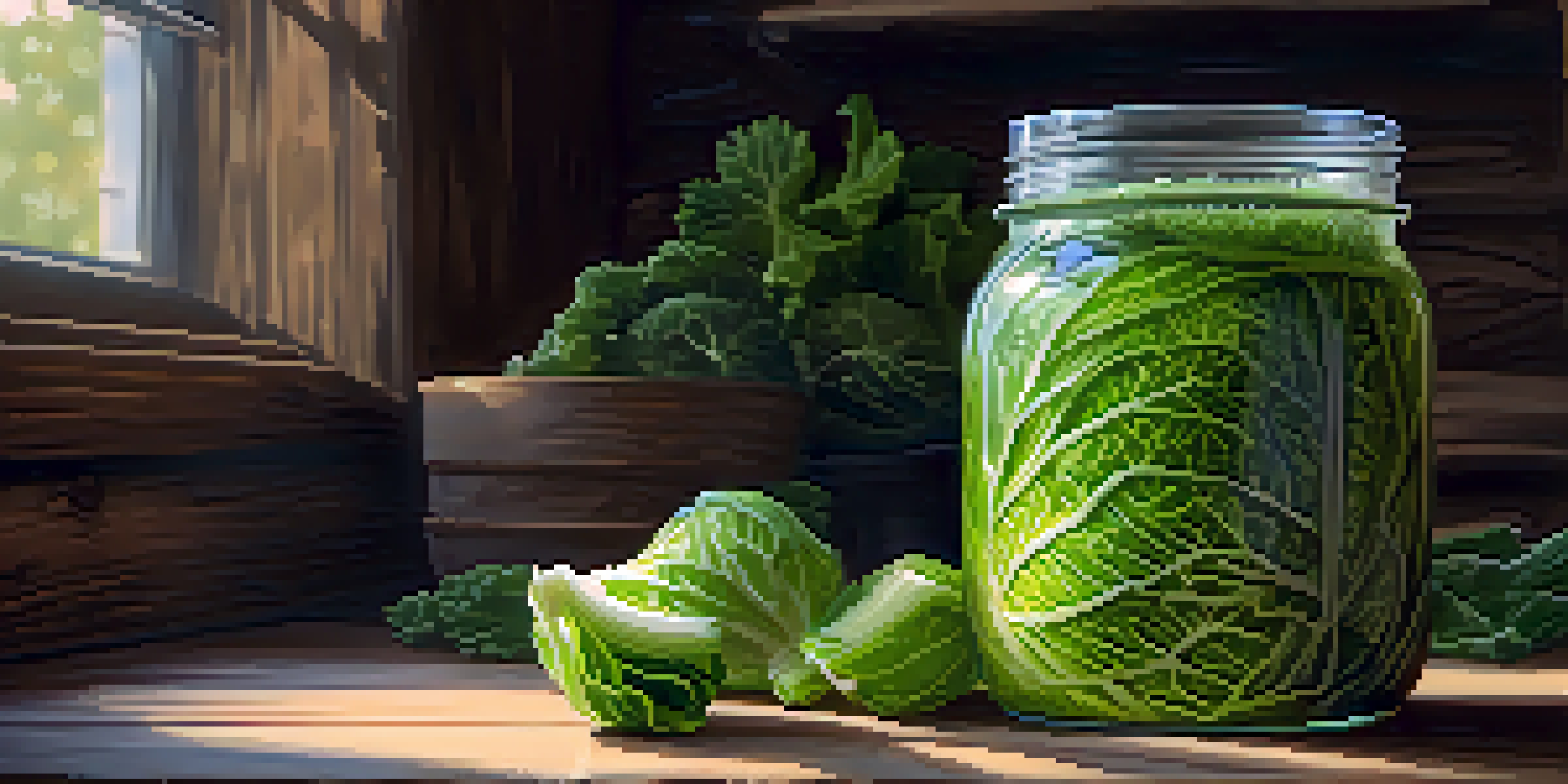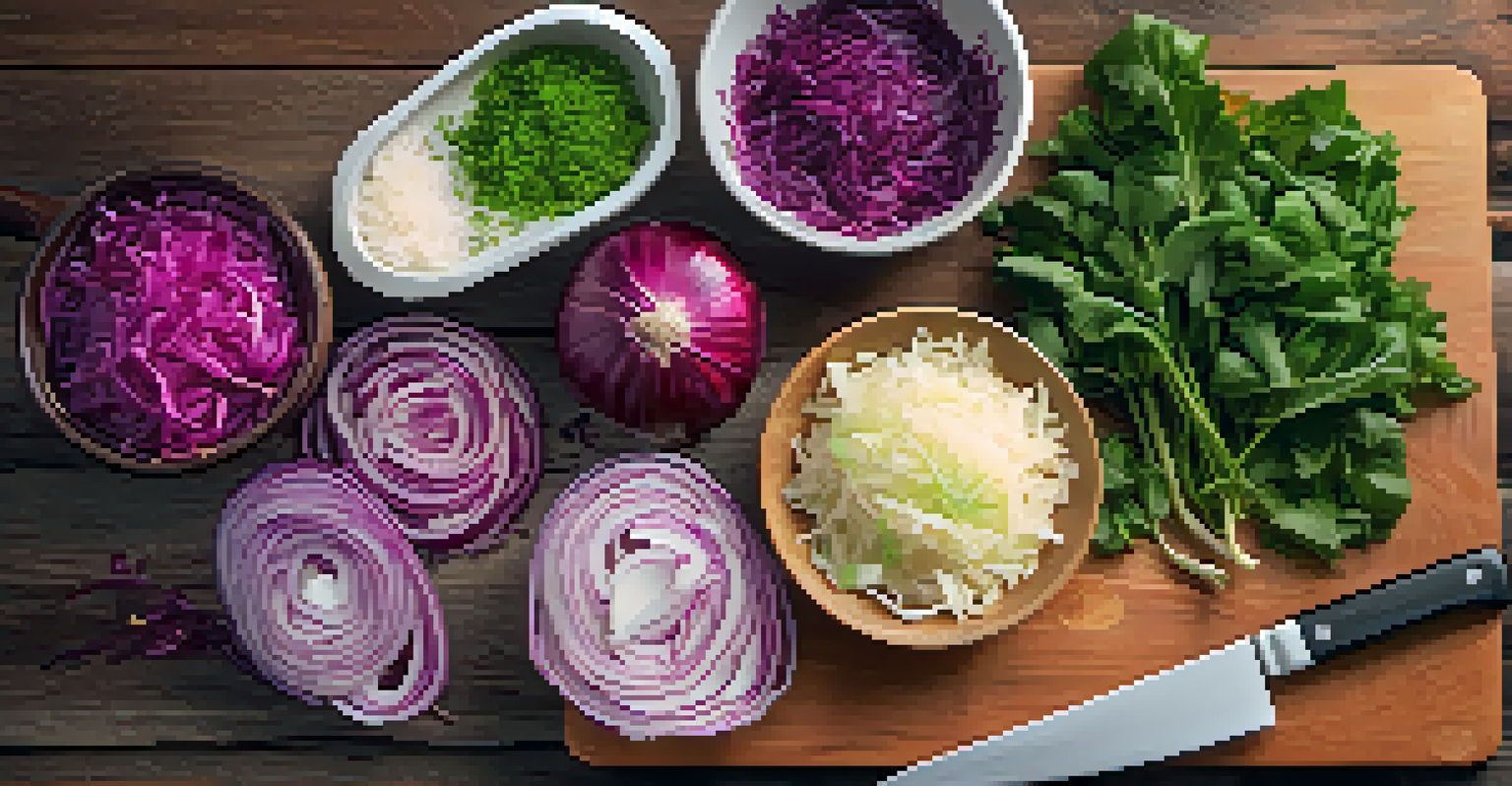Sauerkraut Secrets: Fermenting Cabbage for Health

What is Sauerkraut and Why Is It Special?
Sauerkraut is a fermented food made from finely shredded cabbage. This traditional dish is not just a tasty condiment; it's packed with health benefits that have been celebrated for centuries. The fermentation process transforms simple cabbage into a probiotic powerhouse, making it easier for your body to digest and absorb nutrients.
Food is our common ground, a universal experience.
The magic of sauerkraut lies in the beneficial bacteria that develop during fermentation, particularly Lactobacillus. These probiotics can help improve gut health, boost your immune system, and even enhance your mood. So, when you enjoy this tangy treat, you're not just savoring the flavor; you're also nourishing your body.
Moreover, sauerkraut is rich in vitamins C and K, as well as fiber. Its low-calorie count makes it a fantastic addition to any meal, whether you're looking to enhance flavor or add nutritional value. Understanding what sauerkraut is and its benefits sets the stage for why you should consider making it at home.
The Health Benefits of Fermented Foods
Fermented foods like sauerkraut offer a wealth of health benefits that go beyond simple nutrition. They are known to improve digestion, reduce inflammation, and even support mental health. This is largely due to the presence of probiotics, which are live bacteria that contribute to a healthy gut microbiome.

A healthy gut can lead to better nutrient absorption, helping your body utilize vitamins and minerals more effectively. For instance, studies have shown that probiotics can alleviate symptoms of irritable bowel syndrome (IBS) and enhance overall digestive health. It's fascinating to think that a small serving of fermented cabbage can have such far-reaching effects!
Sauerkraut: A Probiotic Powerhouse
This fermented cabbage dish is not only delicious but also packed with beneficial probiotics that support gut health and boost immunity.
Furthermore, regular consumption of fermented foods has been linked to improved immune function. By promoting a balanced gut microbiome, sauerkraut can help fend off illnesses and infections. It’s a delicious way to fortify your body’s defenses while enjoying a classic comfort food.
How to Choose the Right Cabbage for Fermentation
Selecting the right cabbage is crucial for successful sauerkraut making. You’ll want to opt for fresh, firm heads of cabbage that are free from blemishes. Green cabbage is the most common choice, but you can also experiment with red cabbage for a colorful twist and slightly different flavor profile.
Let food be thy medicine and medicine be thy food.
When choosing your cabbage, aim for organic varieties if possible. Organic cabbage typically has a richer nutrient profile and fewer pesticides, which is especially important when you're fermenting. The natural sugars in the cabbage are what the bacteria will feed on during fermentation, so the quality of your produce matters.
Don’t forget to consider the size of your cabbage! A medium-sized head usually yields enough sauerkraut to fill a quart jar, which is perfect for beginners. Having the right amount of cabbage ensures an optimal fermentation process and provides you with a satisfying batch of sauerkraut to enjoy.
The Fermentation Process: Step by Step
Fermenting cabbage into sauerkraut is a straightforward process that anyone can master. Start by shredding the cabbage and mixing it with salt. The salt draws out moisture from the cabbage while creating an environment that favors the growth of good bacteria over bad ones. This is a critical step in developing the sauerkraut's unique flavor and texture.
Next, pack the salted cabbage tightly into a clean jar, pressing it down to release even more liquid. The goal is to ensure that the cabbage is submerged in its own brine to prevent spoilage. You can use a fermentation weight or a small, clean object to keep the cabbage submerged during fermentation.
Simple Steps to Make Sauerkraut
Fermenting cabbage at home is easy and requires just a few ingredients, including fresh cabbage and salt, to create a tasty and nutritious condiment.
Finally, cover the jar with a cloth or a fermentation lid and let it sit at room temperature for about one to four weeks. Taste it periodically to find the flavor and crunch you enjoy. Once it’s fermented to your liking, seal it and store it in the fridge to halt the fermentation process. That’s it—simple, right?
Common Mistakes to Avoid When Fermenting
Even though fermenting cabbage is quite simple, there are a few common pitfalls to keep in mind. One mistake is using too little salt, which can lead to undesirable fermentation or spoilage. The right salt concentration is crucial for creating the perfect environment for beneficial bacteria to thrive.
Another error is not packing the cabbage tightly enough in the jar. If the cabbage isn’t submerged in the brine, it can spoil instead of ferment. Always ensure that your cabbage is well-pressed down, and consider adding a bit more water if necessary to keep it submerged.
Lastly, don’t forget to keep an eye on the temperature of your fermentation space. Ideally, you want to keep your jar in a cool, dark place to avoid overheating. High temperatures can lead to overly rapid fermentation, which affects the taste and quality of your sauerkraut.
Flavor Variations and Add-Ins for Your Sauerkraut
One of the joys of making sauerkraut at home is the opportunity to experiment with flavors. While traditional sauerkraut is simply cabbage and salt, you can enhance it with various spices and vegetables. Caraway seeds, mustard seeds, or even a splash of apple cider vinegar can add exciting layers of flavor.
You can also mix in other vegetables like grated carrots or sliced radishes for additional nutrition and color. These add-ins not only elevate the taste but also enrich the probiotic content of your sauerkraut. It's a fun way to personalize your batch and make it your own.
Versatile Uses for Sauerkraut
Homemade sauerkraut can enhance a variety of dishes, from salads to soups, making it a flavorful addition to your meals.
Don’t be afraid to get creative! Some people even add fruits like apples or cranberries for a touch of sweetness. There’s no right or wrong when it comes to flavors—experiment and find what combination you enjoy most. The beauty of fermenting at home is that you can tailor it to your taste preferences.
Storing and Using Your Homemade Sauerkraut
Once your sauerkraut is ready, the next step is proper storage. Transfer your finished sauerkraut to airtight containers and keep it in the refrigerator. This will slow down the fermentation process, allowing you to enjoy your creation for several months. The flavors may continue to develop over time, leading to an even tastier experience.
Using sauerkraut in your meals is as versatile as it is delicious. Toss it into salads for a crunchy texture, use it as a topping for sandwiches, or stir it into soups for added depth. The options are endless, and incorporating sauerkraut into your meals is a fantastic way to boost your nutrient intake.

Remember, sauerkraut can also be enjoyed on its own as a side dish. Pair it with your favorite proteins or grain dishes for a well-rounded meal. The tangy, crunchy goodness of homemade sauerkraut is sure to become a staple in your kitchen!